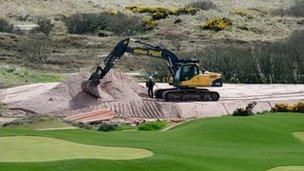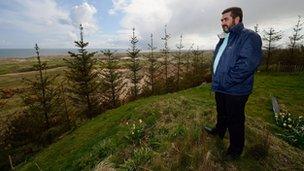Locals split over impact of Donald Trump's golf course at Menie
- Published

Mr Trump says phase two of his development is on hold until the windfarm is killed off
Donald Trump is not known for subtlety.
With trademark hair and trademark chutzpah, he strides onto his golf course at the Menie Estate in Aberdeenshire.
"How's it looking?" I ask him.
"The greatest in the world," is his simple reply.
And, sculpted from shifting sand dunes, the course is impressive.
But plans for a hotel and hundreds of homes on the site, near the village of Balmedie, north of Aberdeen, are on hold.
The tycoon says he won't build them if a windfarm is constructed just offshore.
He has support from some of his neighbours.
One woman, who didn't want to be named, told me that she liked the golf course. It had put up the price of her house, and she didn't care for the wind farm.
But at least one man looking down over the dunes reckons the American has a cheek.
David Milne lives in an old coastguard station, Hermit Point.
It used to be a lonely building perched high above the dunes with, naturally, an amazing view.
No more.
The vista has been blocked by a line of Trump's trees - sitka spruces - which were planted, says the tycoon, to "beautify" the course.
"It's just an example of arrogance and selfish inconsistency," says Mr Milne of Mr Trump.
"He has destroyed an area of outstanding natural beauty, a Site of Special Scientific Interest, and now he's arguing about something that's a mile away and will barely be visible."
How visible is a matter of perspective.
If the wind farm is approved there will be 11 turbines, to be used as a testing ground for the latest technology.

Work on Mr Trump's Aberdeenshire golf course is continuing despite the windfarm controversy
According to its Swedish developers, Vattenfall, the nearest turbine will be around a mile-and-a-half offshore and around two-and-a-half miles from Mr Trump's land.
David Rodger of Vattenfall insists the golfers won't mind.
"We very much believe there is room for both projects," he tells us, looking out over the North Sea from the top of the Aberdeen Exhibition and Conference Centre tower.
The firm wants to be "good neighbours" with the Trump Organisation, he insists.
Nonetheless, Mr Rodger points out that the project was first suggested in 2004, some time before Donald Trump began his battle to build nearby.
And Vattenfall (waterfall in Swedish) has won praise from an unlikely source.
The Royal Society for the Protection of Birds say they have found the company willing to engage with their concerns about the wind farm.
On the dramatic sand dunes to the south of the golf course, the charity's area manager for north east Scotland, Ian Francis, scans the sky with his binoculars.
Overhead is the sweet song of a skylark.

David Milne believes trees planted by Mr Trump are more of an eyesore than the windfarm
The landscape is like a wild, untamed playpark of towering dunes, pristine sand and spiky grasses.
This is what the Trump land looked like before the development began.
It is, claims Mr Francis, the only such stretch of coastline in Britain and much of it, he says, has already been destroyed.
"The damage has been done, regardless of whatever happens now."
Mr Francis doesn't sound that keen on windfarms either. But Vattenfall appear to be winning him round.
"The development has changed enormously over the eight or nine years that this has been brewing up," he says.
"There's been a lot of dialogue... and we are hopeful that we can find a solution to the 11 turbines which are proposed at the moment that means that we are fairly sure the impacts on birds will be minimal."
This, he notes, contrasts with the approach of the Trump Organisation.
Back at the course, Donald Trump himself is on bullish form as he tells me he'll start phase two of the development "as soon as the windfarm idea is killed".
But what if that doesn't happen and the windfarm gets the go-ahead?
"Well I'll have to make a determination at some time, but this is a much bigger project in total than the windfarms and frankly if they do it and they destroy Scotland they will have committed a terrible error," he responds.
As he left the course, he had some advice for the reporters.
"Remember, Trump's a nice guy."
Maybe, but some here would beg to differ.
- Published25 April 2012
- Published24 April 2012
- Published23 April 2012
- Published23 April 2012
- Published20 April 2012
- Published18 April 2012